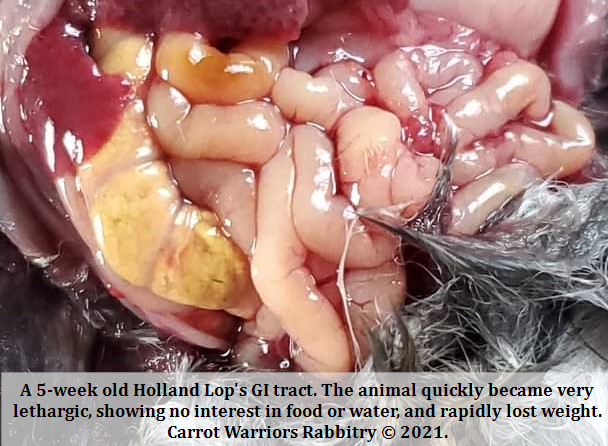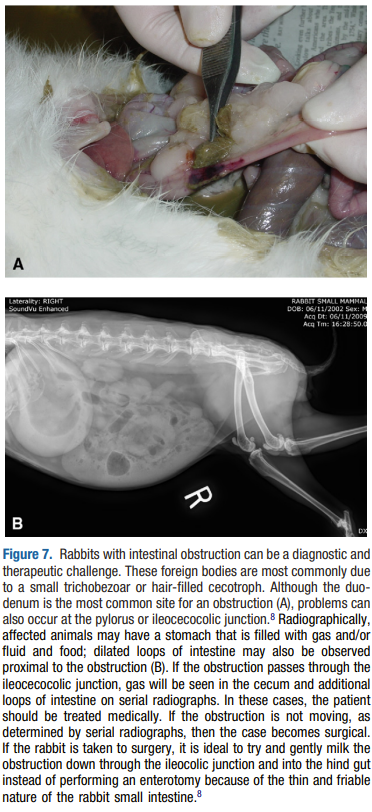Gastrointestinal Stasis (in Rabbits)
Gastrointestinal stasis (GI stasis) is a syndrome known to diminish normal muscular contractions of the stomach and intestines, resulting in dysbiosis.
Woah, wait a minute… What did you just say?
For those who aren't a big science nerd like me, I will simplify it for you. All our vital organs in the body play a critical role to keep our body functioning at optimal capacity, so we can go on about our day. This means that GI stasis causes the rabbit's stomach and intestines to slow down their jobs in the body, so they're performing at "subpar levels" comparatively to the rest of the body. This causes the gut bacteria (intestinal/cecal bacterial flora) to become unbalanced, leading to a variety of digestive disturbances such as cramps, bloat, diarrhea, constipation, etc.
GI stasis doesn't "just happen" if that is what you are wondering to yourself. There are serval factors influencing GI stasis such as incorrect diet, environmental stressors, and pain from underlying conditions.
Diet. Diet. Diet. I'll say it a fourth time, DIET. GI stasis can often be onset from offering simple
carbohydrates along with a lack of crude fiber in their diet. In other words, do not offer your rabbits bread stuffs, cereals, or
an excessive number of treats. With the absence of adequate crude fibre, the motility(transport) of the gut becomes reduced. This
 changes fermentation processes, cecal pH, and bacterial populations. Humans are no different, we also need these healthy options (dark greens)
to help us poop. If we don't poop, we become constipated. Let's be real, guys, no one likes to be constipated. It's not a feeling anyone should
endure. So, rabbits need fiber in their diets to keep their body's functioning at optimal capacity. However, feeding lots of greens, vegetables
and fruits can have negative implications on the body as well, causing GI stasis. Therefore, you will find veterinarians or reputable breeders
telling you to offer hay, ad libitum, so its always available to the rabbit to snack on. Greens, fruits, and vegetables should be offered
in moderation once their stomachs start to get more stable, around 5 months of age. I do not offer anything aside from hay and a ¼ cup
pellets until they're more mature and their stomachs can tolerate changes. Additionally, a low fiber diet results in dental overgrowth, malocclusion,
and facial abscessations. These dental results all lead to reduced food intake, malnutrition, and GI hypomotility (slow transit). I will cover
dental issues on a different day as today is all about the GI stasis.
changes fermentation processes, cecal pH, and bacterial populations. Humans are no different, we also need these healthy options (dark greens)
to help us poop. If we don't poop, we become constipated. Let's be real, guys, no one likes to be constipated. It's not a feeling anyone should
endure. So, rabbits need fiber in their diets to keep their body's functioning at optimal capacity. However, feeding lots of greens, vegetables
and fruits can have negative implications on the body as well, causing GI stasis. Therefore, you will find veterinarians or reputable breeders
telling you to offer hay, ad libitum, so its always available to the rabbit to snack on. Greens, fruits, and vegetables should be offered
in moderation once their stomachs start to get more stable, around 5 months of age. I do not offer anything aside from hay and a ¼ cup
pellets until they're more mature and their stomachs can tolerate changes. Additionally, a low fiber diet results in dental overgrowth, malocclusion,
and facial abscessations. These dental results all lead to reduced food intake, malnutrition, and GI hypomotility (slow transit). I will cover
dental issues on a different day as today is all about the GI stasis.
Lack of daily activity can impair dietary fibre processing, causing negative implications on intestinal motility, which leads to GI stasis. Therefore, it is very important that even if you must cage your rabbit, they should still get a fair amount of activity out of their cage daily to keep their gut motility optimal. Not only is it mentally stimulating to sniff all the good things, but it is essential for good gut motility.
Reduced water intake is another factor effecting gut motility. I personally provide water dishes for my rabbits as I feel they perform a more natural behaviour as they would in the wild, and I find them much easier to clean. However, there is always that "one rabbit" that would much rather drink from a water bottle as opposed to a water dish. So, if you notice your rabbit not drinking a lot, try providing an alternative way for them to access water. Whatever method you choose, monitor their water intake daily and keep their water clean.
There are also various underlying health conditions in rabbits that could onset GI stasis, but I will follow up on those topics in the future. Ultimately, other health conditions will intensitfy chronic stress, so it is a vicious cycle. All you can do is try your best to keep your rabbit happy and healthy to avoid GI stasis.
So, what should I be watching for?
Anorexia or reduced appetite (food or water) are two large symptoms you will find in rabbits with GI stasis. Often you will find the rabbit displaying a "hunched" posture, grinding their teeth, weight loss, small poops, and/or no poop. Some also may develop diarrhea with or without mucus. Additionally, dehydration abdominal distension, gastric tympany, and respiratory or cardiovascular compromise are other symptoms found with GI stasis. With early assessment of the GI stasis, it can be possible to hear their stomachs presenting hyperactive gut sounds (their stomach will be making a lot of noise).
What are some good health tips and what should I do if I see signs of GI stasis?

I always encourage rabbit owners to have a scale on hand to measure the weight of your rabbit at home. From my own experience (+5 years professional exotic animal experience), weight loss is often one of the first indications of sickness in any animal. I weigh my animals at home regularly, it's a very good practice to have.
It is very important to groom your rabbits throughout the seasons as they molt ("shed fur"). Rabbit owners should invest in a couple of good grooming brushes, a slicker is my go-to brush of choice. Rabbits often hold a large amount of food and groomed hair in their stomach, which can lead to "hair-ball obstruction" that shares similar symptoms to GI stasis. Some rabbits are simply not good at grooming their hind end well, ingesting long hair mats that can block the GI tract from working properly. This rarer case can be determined by a radiograph looking for abnormal GI gas patterns, by a licensed professional. Please refer to Figure 7 to see where intestinal obstruction is impacted the most, Image A, and to see what a veterinarian would be watching for on radigraph results, Image B, (Fisher, 2010).
It is always a wise idea to have "Critical Care" from Oxbow on hand. If you cannot get it online, try your local exotic veterinarian. In the event that your rabbit displays early GI stasis symptoms, using Critical Care can help them bounce back better. When rabbits are symptomatic, they're often in a more "critical state" and it is still a good idea to take your rabbit recovering from early GI symptoms to an exotic veterinarian.
At the end of the day, diagnosis of GI stasis requires a thorough physical examination, review of the rabbit's history, and abdominal imaging by a licensed professional. I always encourage rabbit owners to take their rabbits to a specialized exotic veterinarian. They are the professionals and will do everything in their power to help keep your rabbit alive.
References:
1. Campbell-Ward, Michelle L. 2012. "Gastrointestinal physiology and nutrition." Ferrets, Rabbits, and Rodents: Clinical Medicine and Surgery, 3rd edn. Elsevier Saunders, St Louis: 183-192.
2. DeCubellis, Julie, and Jennifer Graham. 2013. "Gastrointestinal disease in Guinea pigs and rabbits." The veterinary clinics of North America. Exotic animal practice 16.2: 421-435.
3. Fisher, Peter G. 2010. "Standards of care in the 21st century: the rabbit." Journal of Exotic Pet Medicine 19.1: 22-35.
4. Huynh, Minh, and Charly Pignon. 2013. "Gastrointestinal Disease in Exotic Small Mammals." Journal of Exotic Pet Medicine 22.2: 118-131. 3
5. Johnson, Dan H. 2012. "Emergency presentations of the exotic small mammalian herbivore trauma patient." Journal of Exotic Pet Medicine 21.4: 300-315.
6. Johnston, Matthew S. 2005. "Clinical approaches to analgesia in ferrets and rabbits." Seminars in Avian and Exotic Pet Medicine. Vol. 14. No. 4.
7. Krsilschikov. K. B. 1986. Investigation of catecholamine effects on the stomach and duodenum motor functions in unanesthetized dogs. Journal of Autonomic Nervous System. 17.1:33-44.
8. Oglesbee, B. L., and J. R. Jenkins. 2012. "Gastrointestinal diseases." Ferrets, Rabbits and Rodents: Clinical Medicine and Surgery. (ed 3). St. Louis, MO, Elsevier/Saunders: 193-204.
9. Ritzman, Tracey K. 2014. "Diagnosis and Clinical Management of Gastrointestinal Conditions in Exotic Companion Mammals (Rabbits, Guinea Pigs, and Chinchillas)." Veterinary Clinics of North America: Exotic Animal Practice 17.2: 179-194.
10. Vella, D., and T. M. Donnelly. 2012. "Basic anatomy, physiology, and husbandry." Ferrets, Rabbits, and Rodents: Clinical Medicine and Surgery.(ed 3). Philadelphia, PA, WB Saunders: 157-173.
11. Welle, Kenneth R. 2015. "Gastrointestinal System." Current Therapy in Exotic Pet Practice: 221.